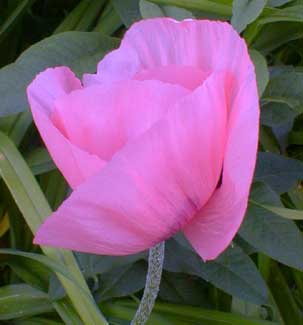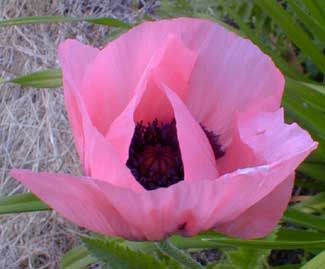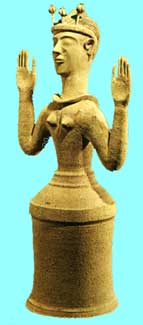
'Juliane'
Pink Perennial Poppy
"Summer set lip to earth's bosom bare,
And left the flushed print in a poppy there."
-Francis Thompson,
1859-1907
1859-1907
Papaver orientale 'Juliane' is a pure faded rose-pink to pale apricot perennial poppy, with a dark plum center but no markings on the petals per se. A mature clump can be a foot & a half tall & two feet wide. Oriental or Perennial poppies attract butterflies & bees to their May & June flowers. Seedpods, ripening in July & August, can be dried for flower arrangement or kitchen use. Foliage is semi-evergreen but can become unsightly in summer, but when yellowed can be cut back to start afresh. The foliage will refresh itself for autumn & become a pleasing half-ferny half-thistle-leaf looking clump, extremely pretty throughout winter.
It is sometimes said to be the great fault of perennial poppies that the foliage gets ragged during the plant's summer dormancy. But it is easy enough to find companion plants such as baby's breath or day lilies that hide the poppy leaves in summer, but which die back reveal the gorgeous leaves in winter. On Puget Sound (Zone 8) they show not even the slightest sign of frost-tenderness but are super-duper foliage clumps throughout winter.
 Cold-hardy to as low as minus 40 or minus 30 Fahrenheit, perennial poppies are native of subalpine regions of Central & West Asia. They are not heat-hardy, but might be grown as winter annuals in Zones 9 or 10.
Cold-hardy to as low as minus 40 or minus 30 Fahrenheit, perennial poppies are native of subalpine regions of Central & West Asia. They are not heat-hardy, but might be grown as winter annuals in Zones 9 or 10.Poppies of numerous species have been associated with the Mother Goddess since antiquity, sacred to Demeter in Europe, & still sacred to Kali in India. Poppies appear in pre-Hellenic Goddess iconography. A terra-cotta figurine from the 13th Century B.C.E. was recovered by Sir Arthur Evans from a small shrine at Gazi west of Knossos in Crete shows the Goddess with arms upraised in blessing, & having three poppy pods on her headdress, as shown in the photo at the left. Several similar figurines showing this Poppy-goddess are now on display at the Herakleion Museum in Crete.
 Although the Cretan Poppy-goddess is often assumed to be an Opium Goddess, this is largely guesswork, & the meaning of the poppy would not have been restricted to its value for mystic altered states. Cretan flower-cults upraised the Crocus, the Lily, & just about any flower that was pretty or useful, so poppies would've been significant with or without narcotic effect. P. argemone, P. lapponicum, P. orientale, as well as P. somniferum would all have been well known in Crete. And Demeter's poppy was usually P. rhoeas devoid of opium, but which typically seeded itself into Demeter's barley fields.
Although the Cretan Poppy-goddess is often assumed to be an Opium Goddess, this is largely guesswork, & the meaning of the poppy would not have been restricted to its value for mystic altered states. Cretan flower-cults upraised the Crocus, the Lily, & just about any flower that was pretty or useful, so poppies would've been significant with or without narcotic effect. P. argemone, P. lapponicum, P. orientale, as well as P. somniferum would all have been well known in Crete. And Demeter's poppy was usually P. rhoeas devoid of opium, but which typically seeded itself into Demeter's barley fields.Any guesses at the nature of the cult would have to take into consideration every potential use for the poppy; the significance of its foliage being most striking in winter; its edibility; & the probability that the appearance of three poppy pods on the head of the Goddess means the number three was itself sacred, & the roundness of pods look like heads wearing hats & may have been regarded as nature's own portraits of the crowned Mother Goddess.
Another famous Goddess image is on a seal which shows the Mother Goddess seated, offering three poppy pods in her right hand, while supporting her breast with her left hand. Here again it is not just the poppy but Three Poppy Pods that have meaning. If this is perceived as a Goddess of Life & Death, she cups her breast as a signal of life, & offers the poppy pods as a symbol of death. As a symbol of death, the pod's resemblance to Persephone's pomegranate may have been as significant or more significant than the capacity of poppy latext to induce sleep. The black poppy, which would not likely have meant the opium poppy which is naturally bright red, was sacred to Hecate, according to the Argonautica, so even when the poppy was associated with the underworld, it must have had meaning more all-encompassing than as an opiate.
Latex from poppies other than the opium poppy do function as sleep-regulators, but without the addictive properties. When Demeter devoured poppies in order to sleep during her grief at the absence of Persephone, it is a larger leap of guesswork that only the opium poppy is to be considered. The poppy is known to have been sacred to Demeter at Eleusis, but it is shown in tandem with grain, indicating that its value was as much as anything for a flavoring in barley cakes of Demeter as Corn Mother.
Hippocrates notes both nutritious & medicinal values for poppies & distinguishes between red, white, & black varieties. Theophrastus names varieties of poppies as do several other ancient authorities. Dioskourides in the first century C.E. states that the poppy from which opiates were derived was distinct from a cultivated poppy grown so that the seeds might be mixed with bread; he also notes that the seeds from any variety can be used to assist sleep; & when he speaks of the wild "Jar Poppy" he probably means P. orientale.
When it is understood that even poppies without opiating properties were sacred, a far broader nature of this divine emblem can be surmised: valued for its perfume & as an incense offering, as an ornamental, for food, as a drug, for its pods' resemblance to pomegranates, for the pod's "crowned head" indicative of queenship or divinity but also symbolic of protective city walls; a symbol of blood for red varieties, death for the black center; used as a love-charm or aphrodesiac hence a fertility emblem; & having other meanings & uses.
The addition of the number Three suggests a triad of goddesses such as were so common throughout the ancient world & frequently associated with Fate & rule of Past, Present, & Future. In Cretan cult, the three most common forms of the Mother Goddess were Snake-goddess (Underworld), Dove-goddess (Sky), & Artemis-like Huntress (World); & in each Goddess was another triad of Maiden, Matron, & Crone.